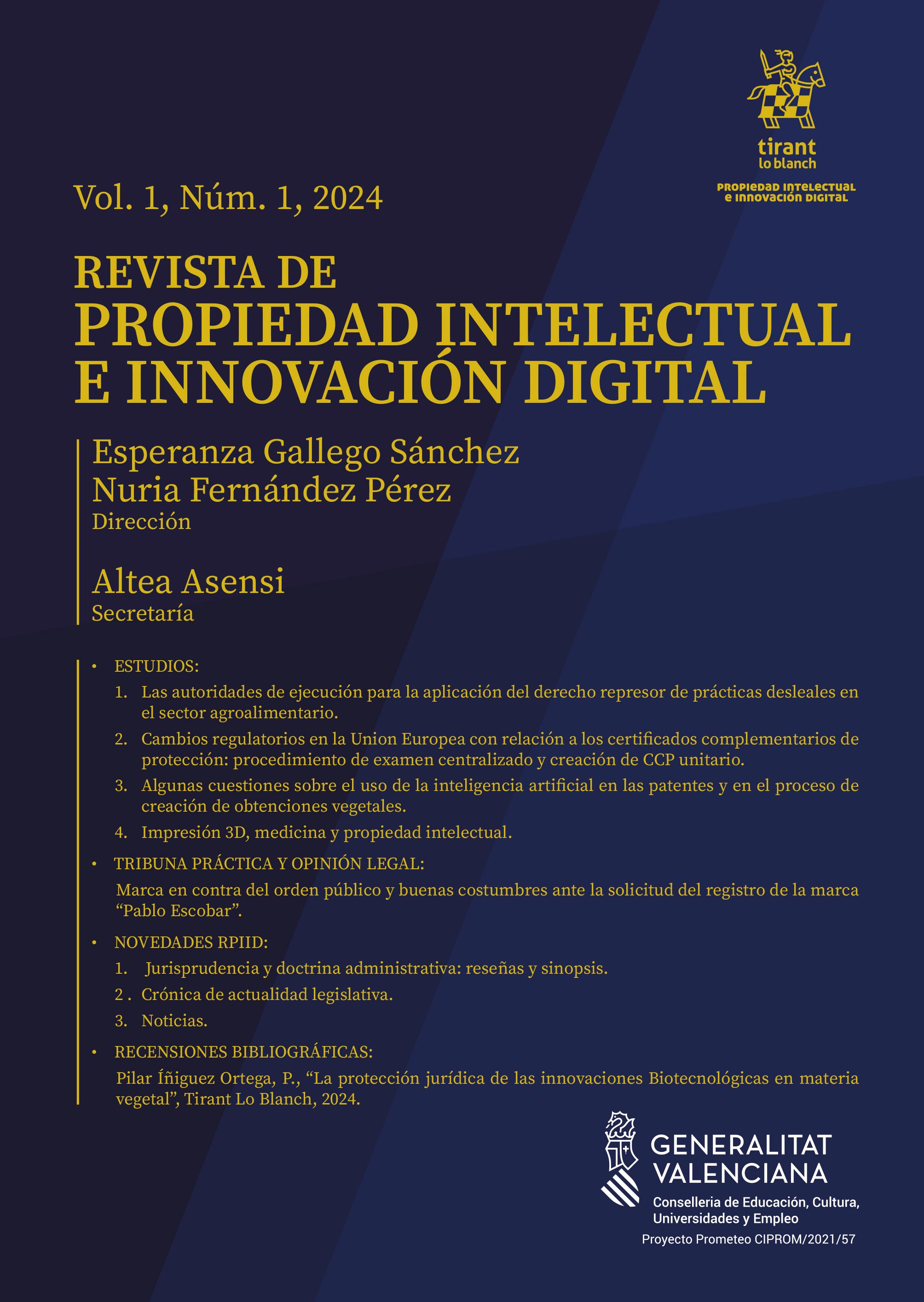Some questions about the use of Artificial Intelligence in patents and in the process of creating plant varieties
DOI:
https://doi.org/10.36151/RPIID.2024.1.1.01Keywords:
Artificial Intelligence, Patent, Plant Breeders' Rights, DUS, UPOVAbstract
Artificial Intelligence is a necessary element for precision agriculture. Machine Learning systems enable a much more efficient analysis of Big Data that is not only leading to higher productivity on farms, but also to phenotypically and genotypically distinguish plant varieties in DUS tests, although this has not yet been approved by UPOV in its Guidelines. Being generative and, in some cases, autonomous, Artificial Intelligence can create biotechnological inventions and new plant varieties. If such creations give rise to patent or plant variety applications, these will not be admissible, as patent law requires the inventor to be a natural person, and UPOV requires the breeder to be a person, and Artificial Intelligence is not. This does not preclude the use of Artificial Intelligence by an inventor or a breeder, which may give rise to legal problems that the legislator should address.
References
ALFARO ÁGUILA-REAL, Jesús (2023) La persona jurídica. Ed. Comares, 2023.
ATIENZA NAVARRO, M.ª Luisa (2023) “¿Son necesarias reglas especiales para los daños ca sados por Inteligencia Artificial?”, en HERBOSA MARTÍNEZ, Inmaculada (Dir.) y FERNÁN-DEZ DE RETANA GOROSTIZAGOIZA, David (Dir.), Derecho e Inteligencia Artificial. El jurista ante los retos de la era digital. Editorial Aranzadi, Cizur Menor, 2023, p. 387-425.
BLANCO, José María / COHEN, Jessica. (2018) “Inteligencia artificial y poder”, ARI 93/2018, 24 de julio de 2018. https://media.realinstitutoelcano.org/wp-content/uploads/2018/07/ari93-2018-blanco-cohen-inteligencia-artificial-poder.pdf
EUROPEAN PATENT OFFICE (2024) Guidelines for Examination in the European Patent Of-fice. Versión de marzo de 2024. https://link.epo.org/web/legal/guidelines-epc/en-epc-guidelines-2024-hyperlinked-showing-modifications.pdf Part F – Chapter II-3.3.1. Artifi-cial intelligence and machine learning.
EUROPEAN PATENT OFFICE (2024) Guidelines for Examination in the European Patent Of-fice. Versión de marzo de 2024. https://link.epo.org/web/legal/guidelines-epc/en-epc-guidelines-2024-hyperlinked-showing-modifications.pdf Part F – Chapter III-2. 3. Insuf-ficient disclosure
GALLEGO SÁNCHEZ, Esperanza. “La patentabilidad de la inteligencia artificial. La compa-tibilidad con otros sistemas de protección”. LA LEY mercantil, No 59, junio de 2019, p. 5 de 24.
GARCÍA-ARTEAGA y ZAMBRANO-ZAMBRANO y ALCIVAR-CEVALLOS; ZAMBRANO-ROMERO (2020). “Predicción del rendimiento de cultivos agrícolas usando aprendizaje automáti-co”. Revista Arbitrada Interdisciplinaria KOINONIA. Año 2020. Vol. V. N°2. Especial: Sa-ber y Tecnología Popular. http://dx.doi.org/10.35381/r.k.v5i2.1013
GARCÍA VIDAL, Ángel (2017) “Capítulo 10. El derecho a la protección de una variedad vegetal por medio de una obtención vegetal”, en GARCÍA VIDAL, Ángel (Dir.) Derecho de las obtenciones vegetales. Editorial Tirant lo Blanch, Valencia, 2017, p. 450-454.
ÍÑIGUEZ ORTEGA, Pilar (2021). “Intellectual property rights, artificial intelligence and big data:future perspectives”, Actas de derecho industrial y derecho de autor, Tomo 41, 2020-2021, p. 109-132.
MARTÍN, Cristian y LLOPIS, Luis y RUBIO, Bartolomé y DÍAZ, Manuel (2021) “Revisión de tecnologías habilitadoras para el control biológico y de plagas en el sector hortofrutíco-la”, en XLII Jornadas de Automática: Libro de actas, August 2021 (p.744-751). DOI:10.17979/spudc.9788497498043.744
NIAZIAN, Mohsen y NIEDBAŁA, Gniewko (2021) “Machine Learning for Plant Breeding and Biotechnology”, en Artificial Neural Networks in Agriculture (Sebastian Kujawa y Gniewko Niedbała). MDPI Basel (Suiza). 2021, p. 131-153. También en Agriculture 2020, 10, 436, doi:10.3390/agriculture10100436.
RAPELA, Miguel A (2020) “Mejoramiento vegetal moderno, inteligencia artificial y de-rechos de propiedad intelectual”, Revista Jurídica Austral, Vol. 1 Núm. 2 (2020) Di-ciembre 2020, p. 839-868. DOI: https://doi.org/10.26422/RJA.2020.0102.rap
SAINZ DE AJA IRAPU, Borja (2023) “Inteligencia Artificial y Propiedad Intelectual”, en HERBOSA MARTÍNEZ, Inmaculada (dir.) y FERNÁNDEZ DE RETANA GOROSTIZAGOIZA, David (dir.), Derecho e Inteligencia Artificial. El jurista ante los retos de la era digital. Editorial Aranzadi, Cizur Menor, 2023, p. 247-269.
SÁNCHEZ GARCÍA, Luz (2022) “Las «pseudoinvenciones» generadas por algoritmos, ¿ja-que al estado de la técnica?”, CEFLegal: Revista práctica de derecho. Comentarios y ca-sos prácticos, ISSN-e 2697-2239, ISSN 2697-1631, No. 262, 2022, págs. 5-34
SINGH, Rajesh, GEHLOT, Anita, PRAJAPAT, Mahesh Kumar, SINGH, Bhupendra (2022) “Chapter 11. Species Recongnition in Flowers”, Artificial Intelligence in Agriculture. Ed. CRC (Taylor Francis Group), Boca Raton (Florida), 2022, p. 151-167.
SINGH, Rajesh, GEHLOT, Anita, PRAJAPAT, Mahesh Kumar, SINGH, Bhupendra (2022) “Chapter 12. Precision Farming”, Artificial Intelligence in Agriculture. Ed. CRC (Taylor Francis Group), Boca Raton (Florida), 2022, p. 168-179.
TUTT, A. (2017) “An FDA for algorithms”, Administrative Law Review 83 (2017), ttps://papers.ssrn.com/sol3/papers .cfm?abstract_id=2747994, págs.. 1 y ss.
UNIÓN INTERNACIONAL PARA LA PROTECCIÓN DE LAS OBTENCIONES VEGETALES (2001) Development of Test Guidelines. Associated Document to the General Introduc-tion to the Examination of Distinctness, Uniformity and Stability and the Development of Harmonized Descriptions of New Varieties of Plants. https://www.upov.int/test_guidelines/en/introduction.html TG/1/3,
UNIÓN INTERNACIONAL PARA LA PROTECCIÓN DE LAS OBTENCIONES VEGETALES (2002) La noción de obtentor y de lo notoriamente conocido. CONSEJO. Decimonovena sesión ex-traordinaria Ginebra, 19 de abril de 2002. Revisión del documento C(Extr.)/19/2. C(Extr.)/19/2 Rev. FECHA: 9 de agosto de 2002.
UNIÓN INTERNACIONAL PARA LA PROTECCIÓN DE LAS OBTENCIONES VEGETALES (2013) Notas explicativas sobre la definición de obtentor con arreglo al acta de 1991 del con-venio de la UPOV, adoptado por el Consejo en su cuadragésima séptima sesión ordinaria el 24 de octubre de 2013. UPOV/EXN/BRD/1. FECHA: 24 de octubre de 2013.
UNIÓN INTERNACIONAL PARA LA PROTECCIÓN DE LAS OBTENCIONES VEGETALES (2023). Discussion on molecular techniques in DUS examination - United Kingdom. October 16, 2023. https://www.upov.int/meetings/en/doc_details.jsp?meeting_id=77230&doc_id=621765
UNIÓN INTERNACIONAL PARA LA PROTECCIÓN DE LAS OBTENCIONES VEGETALES (2024) Use of Artificial Intelligence–Based Markers for Variety Traceability. Documento UPOV. TWM/2/9. March 11, 2024. https://www.upov.int/edocs/mdocs/upov/en/twm_2/twm_2_9.pdf
VELASCO-MATA, Alberto y VALLEZ, Noelia y RUIZ-SANTAQUITERIA, Jesus y PEDRAZA, Anibal y BUENO, Gloria y DENIZ, Oscar (2022). “Métodos de Inteligencia Artificial para la Predicción de Componentes Químicos a partir de Imágenes Hiperespectrales”, en XLIII Jornadas de Automática Visión por computador. Libro de actas, 2022.
Downloads
Published
Issue
Section
License
Copyright (c) 2024 Revista propiedad intelectual e innovación digital

This work is licensed under a Creative Commons Attribution-NonCommercial-NoDerivatives 4.0 International License.




